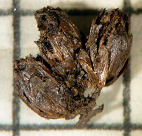Henge 1 & Dagger Cist
The site of the largest henge (Henge 1) at Forteviot was the focus of activity and ritual over many centuries in prehistory and than again, several millennia later, in the Pictish period. During the Later Neolithic a henge – a space for ritual gatherings defined by a large ditch and earthen bank - was created, replacing an earlier timber circle and encompassing part of an earlier cremation cemetery. In the Bronze Age the henge was adapted when a large cairn covering a megalithic cist burial was inserted into the ditch. Although there are a few traces of later prehistoric presence in the area, it is only again in the Pictish period that the monument is clearly redefined with a large pit cut in the centre of the henge.
Cremation Cemetery
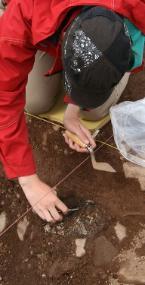 Before the henge was constructed this location was the site of a cremation cemetery. Excavations uncovered eight discrete burials alongside evidence of more extensive deposits dating to the beginning of Later Neolithic period 3000-2800BC, likely before the large palisaded enclosure was erected. The discrete bundles of cremated bone were placed in pits, some buried in organic bags or wooden vessels. Cremation cemeteries of Neolithic date are incredibly rare in Scotland, and the closest parallel beyond is a large cremation cemetery found within Stonehenge, which is of a similar date.
Before the henge was constructed this location was the site of a cremation cemetery. Excavations uncovered eight discrete burials alongside evidence of more extensive deposits dating to the beginning of Later Neolithic period 3000-2800BC, likely before the large palisaded enclosure was erected. The discrete bundles of cremated bone were placed in pits, some buried in organic bags or wooden vessels. Cremation cemeteries of Neolithic date are incredibly rare in Scotland, and the closest parallel beyond is a large cremation cemetery found within Stonehenge, which is of a similar date.
Timber Circle
After a few centuries, about the same time as the construction of the palisaded enclosure, a smaller timber circle was built around the site of the cremation cemetery. Measuring over 40m in diameter the timber circle was built of massive oak posts – creating an enclosed space of unknown function.
The Henge
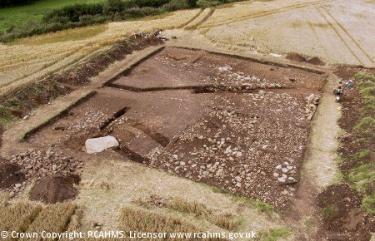
One of the more peculiar elements of the cropmark complex at Forteviot, located to the south of the henge, is a very small ‘henge monument’, only 8m in diameter with a ditch 2.5m wide. The elements of this monument mirror the larger henge, right down to having a single entrance on the northwest side and a timber circle. The function of this monument and its relationship to the large henge is unknown.
The Cist & Dagger Burial
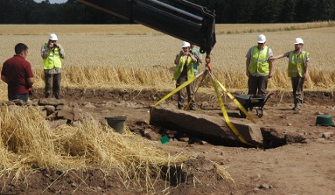
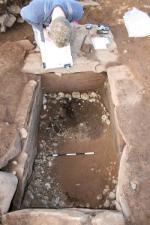 The cist was built around 2100 - 1950BC, some 500 years after the henge was constructed. Placed within a large pit, the sides of the cist were composed of large sandstone slabs supported by packing stones (measuring 1.7m NE-SW by 1.15m). Specially selected waterworn pebbles formed the floor of the cist with large quartz pebbles positioned in the south-west end. A layer or mat of birch bark was then laid on the floor of the cist – in preparation for internment. Although bones have not survived in situ, traces of re-mineralised bone was identified adhering to the sides of the cist attesting to the presence of a body in the cist. Accompanying the body was a rich collection of grave goods, including a bronze dagger and knife, two wooden containers and other organic and stone objects. Click here to read more about the contents of the cist.
The cist was built around 2100 - 1950BC, some 500 years after the henge was constructed. Placed within a large pit, the sides of the cist were composed of large sandstone slabs supported by packing stones (measuring 1.7m NE-SW by 1.15m). Specially selected waterworn pebbles formed the floor of the cist with large quartz pebbles positioned in the south-west end. A layer or mat of birch bark was then laid on the floor of the cist – in preparation for internment. Although bones have not survived in situ, traces of re-mineralised bone was identified adhering to the sides of the cist attesting to the presence of a body in the cist. Accompanying the body was a rich collection of grave goods, including a bronze dagger and knife, two wooden containers and other organic and stone objects. Click here to read more about the contents of the cist.
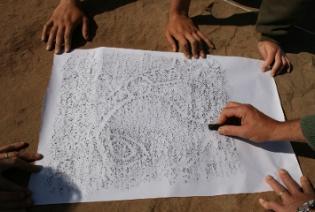 The cist and its contents were then quickly sealed the huge sandstone capstone. This stone must have been skilfully transported, possibly from an outcrop several miles to the north of the site on the other side of the River Earn. Examination of the underside of the capstone revealed an enigmatic carving, which could be described as a stylised axe or club with a spiral or ‘eye-shaped’ tail. After the cist was sealed it was covered by a cairn of smaller stones.
The cist and its contents were then quickly sealed the huge sandstone capstone. This stone must have been skilfully transported, possibly from an outcrop several miles to the north of the site on the other side of the River Earn. Examination of the underside of the capstone revealed an enigmatic carving, which could be described as a stylised axe or club with a spiral or ‘eye-shaped’ tail. After the cist was sealed it was covered by a cairn of smaller stones.
Pictish Activity at Henge 1
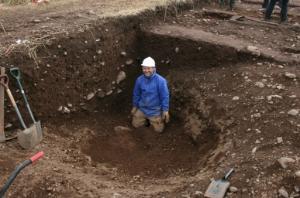 After the Bronze Age cist was covered over there does not seem to be substantial reworking or activity on the site until the Pictish period (around 600AD) when a large pit, over 10m in diameter and 1.5m deep was dug in the centre of the henge. Although its function is unclear, the location of the pit within the henge is unlikely to be a coincidence; perhaps these ancient monuments were being robbed? Thousands of years after it was first built the henge was likely still visible and became a focus of activity once again. In the upper fill of the pit were a few iron and lead fragments as well as sherds of Roman amphora and medieval pottery suggesting that the pit was deliberately backfilled in the medieval period (around 1200 AD). Also in a later period the upper fill of the henge ditch was levelled by a thick layer of rubble. Objects within this rubble layer include prehistoric worked lithics, a glass droplet and metal objects.
After the Bronze Age cist was covered over there does not seem to be substantial reworking or activity on the site until the Pictish period (around 600AD) when a large pit, over 10m in diameter and 1.5m deep was dug in the centre of the henge. Although its function is unclear, the location of the pit within the henge is unlikely to be a coincidence; perhaps these ancient monuments were being robbed? Thousands of years after it was first built the henge was likely still visible and became a focus of activity once again. In the upper fill of the pit were a few iron and lead fragments as well as sherds of Roman amphora and medieval pottery suggesting that the pit was deliberately backfilled in the medieval period (around 1200 AD). Also in a later period the upper fill of the henge ditch was levelled by a thick layer of rubble. Objects within this rubble layer include prehistoric worked lithics, a glass droplet and metal objects.
 The precise nature of this and later activity on the site is still to be resolved; nonetheless, what is clear is that this monument was a powerful magnet for activity over millennia.
The precise nature of this and later activity on the site is still to be resolved; nonetheless, what is clear is that this monument was a powerful magnet for activity over millennia.


